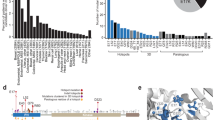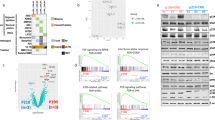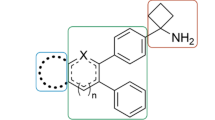Abstract
Although pathologically activated ABL1 fusion kinases represent well-validated therapeutic targets, tumor genomic sequencing has identified numerous point mutations in the ABL1 proto-oncogene of unclear significance. Here we describe ten novel ABL1 1b point mutations, including two from clinical isolates, that cause constitutive kinase activation and cellular transformation. All mutants retained sensitivity to ATP-competitive tyrosine kinase inhibitors (TKIs). Several substitutions cluster near the myristoyl-binding pocket, the target of ABL001, a novel clinically active allosteric kinase inhibitor that mimics the autoinhibitory myristoyl group, and likely activate the kinase by relieving physiologic autoinhibition. In addition, several mutations activate the kinase and confer resistance to allosteric inhibition despite a lack of proximity to this region. We demonstrate that BCR-ABL1 and ABL1 1b point mutations can co-exist in a proportion of clinical cases as a consequence of the chromosome 9 breakpoint location. Collectively, our findings support clinical investigation of ATP-competitive TKIs in malignancies harboring ABL1 point mutations, and sequencing of BCR-ABL1 and ABL1 1b in patients with acquired resistance to allosteric ABL1 inhibitors.
This is a preview of subscription content, access via your institution
Access options
Subscribe to this journal
Receive 12 print issues and online access
$259.00 per year
only $21.58 per issue
Buy this article
- Purchase on Springer Link
- Instant access to full article PDF
Prices may be subject to local taxes which are calculated during checkout








Similar content being viewed by others
References
Hantschel O . Structure, regulation, signaling, and targeting of Abl kinases in cancer. Genes Cancer 2012; 3: 436–446.
Golub TR, Goga A, Barker GF, Afar DEH, McLaughlin J, Bohlander SK et al. Oligomerization of the ABL tyrosine kinase by the Ets protein TEL in human leukemia. Mol Cell Biol 1996; 16: 4107–4116.
De Keersmaecker K, Rocnik JL, Bernad R, Lee BH, Leeman D, Gielen O et al. Kinase activation and transformation by NUP214-ABL1 is dependent on the context of the nuclear pore. Mol Cell 2008; 31: 134–142.
De Keersmaecker K, Graux C, Odero MD, Mentens N, Somers R, Maertens J et al. Fusion of EML1 to ABL1 in T-cell acute lymphoblastic leukemia with cryptic t(9;14)(q34;q32). Blood 2005; 105: 4849–4852.
Hantschel O, Superti-Furga G . Regulation of the c-Abl and Bcr–Abl tyrosine kinases. Nat Rev Mol Cell Biol 2004; 5: 33–44.
Hantschel O, Nagar B, Guettler S, Kretzschmar J, Dorey K, Kuriyan J et al. A myristoyl/phosphotyrosine switch regulates c-Abl. Cell 2003; 112: 845–857.
Nagar B, Hantschel O, Young MA, Scheffzek K, Veach D, Bornmann W et al. Structural basis for the autoinhibition of c-Abl tyrosine kinase. Cell 2003; 112: 859–871.
Barilá D, Superti-Furga G . An intramolecular SH3-domain interaction regulates c-Abl activity. Nat Genet 1998; 18: 280–282.
Cerami E, Gao J, Dogrusoz U, Gross BE, Sumer SO, Aksoy BA et al. The cBio Cancer Genomics Portal: an open platform for exploring multidimensional cancer genomics data. Cancer Discov 2012; 2: 401–404.
Gao J, Aksoy BA, Dogrusoz U, Dresdner G, Gross B, Sumer SO et al. Integrative analysis of complex cancer genomics and clinical profiles using the cBioPortal. Sci Signal 2013; 6: pl1.
Azam M, Seeliger MA, Gray NS, Kuriyan J, Daley GQ . Activation of tyrosine kinases by mutation of the gatekeeper threonine. Nat Struct Mol Biol 2008; 15: 1109–1118.
Allen PB, Wiedemann LM . An activating mutation in the ATP binding site of the ABL kinase domain. J Biol Chem 1996; 271: 19585–19591.
Azam M, Latek RR, Daley GQ . Mechanisms of autoinhibition and STI-571/imatinib resistance revealed by mutagenesis of BCR-ABL. Cell 2003; 112: 831–843.
Azam M, Raz T, Nardi V, Opitz SL, Daley. GQ . A screen to identify drug resistant variants to target-directed anti- cancer agents. Biol Proced Online 2003; 5: 204–210.
Smith CC, Wang Q, Chin C-S, Salerno S, Damon LE, Levis MJ et al. Validation of ITD mutations in FLT3 as a therapeutic target in human acute myeloid leukaemia. Nature 2012; 485: 260–263.
Branford S, Zbigniew R, Walsh S, Grigg A, Arthur C, Taylor K et al. High frequency of point mutations clustered within the adenosine triphosphate–binding region of BCR/ABL in patients with chronic myeloid leukemia or Ph-positive acute lymphoblastic leukemia who develop imatinib (STI571) resistance. Blood 2002; 99: 3472–3475.
Shah NP, Kasap C, Weier C, Balbas M, Nicoll JM, Bleickardt E et al. Transient potent BCR-ABL inhibition is sufficient to commit chronic myeloid leukemia cells irreversibly to apoptosis. Cancer Cell 2008; 14: 485–493.
Toy W, Shen Y, Won H, Green B, Sakr RA, Will M et al. ESR1 ligand-binding domain mutations in hormone-resistant breast cancer. Nat Genet 2013; 45: 1439–1445.
The Cancer Genome Atlas Research Network. Genomic and epigenomic landscapes of adult de novo acute myeloid leukemia. N Engl J Med 2013; 368: 2059–2074.
Warmuth M, Kim S, Gu X-J, Xia G, Adrian F . Ba/F3 cells and their use in kinase drug discovery. Curr Opin Oncol 2007; 19: 55–60.
Brasher BB, Roumiantsev S, Van Etten RA . Mutational analysis of the regulatory function of the c-Abl Src homology 3 domain. Oncogene 2001; 20: 7744–7752.
Fabbro D, Manley PW, Jahnke W, Liebetanz J, Szyttenholm A, Fendrich G et al. Inhibitors of the Abl kinase directed at either the ATP- or myristate-binding site. Biochim Biophys Acta 2010; 1804: 454–462.
Zhang J, Adrián FJ, Jahnke W, Cowan-Jacob SW, Li AG, Iacob RE et al. Targeting Bcr-Abl by combining allosteric with ATP-binding-site inhibitors. Nature 2010; 463: 501–506.
Sellers WR .Dual targeting of BCR-ABL with ABL001: a novel potent allosteric ABL kinase inhibitor in combination with nilotinib suppresses the emergence of disease resistance in models of CML. Proceedings of the AACR Annual Meeting: Philadelphia, PA, USA,2015.
Wylie A, Schoepfer J, Berellini G ABL001, a potent allosteric inhibitor of BCR-ABL, prevents emergence of resistant disease when administered in combination with nilotinib in an in vivo murine model of chronic myeloid leukemia.Proceedings of the 56th ASH Annual Meeting and Exposition: San Francisco, CA, USA, 2014.
Adrián FJ, Ding Q, Sim T, Velentza A, Sloan C, Liu Y et al. Allosteric inhibitors of Bcr-abl–dependent cell proliferation. Nat Chem Biol 2006; 2: 95–102.
Million RP, Harakawa N, Roumiantsev S, Varticovski L, Van Etten RA . A direct binding site for Grb2 contributes to transformation and leukemogenesis by the Tel-Abl (ETV6-Abl) tyrosine kinase. Mol Cell Biol 2004; 24: 4685–4695.
Million RP, Van Etten RA . The Grb2 binding site is required for the induction of chronic myeloid leukemia-like disease in mice by the Bcr/Abl tyrosine kinase. Blood 2000; 96: 664–670.
Goga A, McLaughlin J, Afar DEH, Saffran DC, Witte ON . Alternative signals to RAS for hematopoietic transformation by the BCR-ABL oncogene. Cell 1995; 82: 981–988.
Melo JV, Gordon DE, Cross NCP, Goldman JM . The ABL-BCR fusion gene is expressed in chronic myeloid leukemia. Blood 1993; 81: 158–165.
Morris CM, Heisterkamp N, Groffen J, Fitzgerald PH . Entire ABL gene is joined with 5′-BCR in some patients with Philadelphia-positive leukemia. Blood 1991; 78: 1078–1084.
Jiang X, Trujillo JM, Liang JC . Chromosomal breakpoints within the first intron of the ABL gene are nonrandom in patients with chronic myelogenous leukemia. Blood 1990; 76: 597–601.
Groffen J, Stephenson JR, Heisterkamp N, de Klein A, Bartram CR, Grosveld G . Philadelphia chromosomal breakpoints are clustered within a limited region, bcr, on chromosome 22. Cell 1984; 36: 93–99.
Uphoff CC, Habig S, Fombonne S, Matsuo Y, Drexler HG . ABL-BCR expression in BCR-ABL-positive human leukemia cell lines. Leuk Res 1999; 23: 1055–1060.
Testoni E, Stephenson NL, Torres-Ayuso P, Marusiak AA, Trotter EW, Hudson A et al. Somatically mutated ABL1 is an actionable and essential NSCLC survival gene. EMBO Mol Med 2016; 8: 105–116.
Dasgupta Y, Koptyra M, Hoser G, Kantekure K, Roy D, Gornicka B et al. Normal ABL1 is a tumor suppressor and therapeutic target in human and mouse leukemias expressing oncogenic ABL1 kinases. Blood 2016; 127: 2131–2143.
Badger J, Grover P, Shi H, Panjarian SB, Engen JR, Smithgall TE et al. c-Abl tyrosine kinase adopts multiple active conformational states in solution. Biochemistry 2016; 55: 3251–3260.
Pluk H, Dorey K, Superti-Furga G . Autoinhibition of c-Abl. Cell 2002; 108: 247–259.
Yokota A, Hirai H, Shoji T .C-terminal domain of ABL family kinases, ABL and ARG, defines their distinct leukemogenic activitiesin vivoProceedings of the 56th ASH Annual Meeting and Exposition:San Francisco, CA, USA, 2014.
Choi Y, Seeliger MA, Panjarian SB, Kim H, Deng X, Sim T et al. N-myristoylated c-Abl tyrosine kinase localizes to the endoplasmic reticulum upon binding to an allosteric inhibitor. J Biol Chem 2009; 284: 29005–29014.
Iacob RE, Zhang J, Gray NS, Engen JR . Allosteric interactions between the myristate- and ATP-site of the Abl kinase. PLoS ONE 2011; 6: e15929.
Goga A, McLaughlin J, Pendergast AM, Parmar K, Muller A, Rosenberg N et al. Oncogenic activation of c-ABL by mutation within its last exon. Mol Cell Biol 1993; 13: 4967–4975.
Acknowledgements
We thank members of the Shah laboratory for reading of the manuscript and Lucky Ding for technical assistance; Sarat Chandarlapaty, Tim Ley and Matthew Wieduwilt for providing information on clinically identified ABL1 point mutations; and Farid Chehab for providing clinical samples. This work was supported by the Edward S Ageno family, Stephen Worsham and Mark Maymar. NPS has received research funding from ARIAD, Bristol-Myers Squibb and Plexxikon for costs related to the conduct of clinical trials, and research grants from Pfizer and Daiichi-Sankyo for laboratory research unrelated to this work.
Author information
Authors and Affiliations
Corresponding author
Ethics declarations
Competing interests
NPS has received research funding from ARIAD, Bristol-Myers Squibb and Plexxikon for costs related to the conduct of clinical trials, and research grants from Pfizer and Daiichi-Sankyo for laboratory research unrelated to this work.
Additional information
Supplementary Information accompanies this paper on the Leukemia website
Supplementary information
Rights and permissions
About this article
Cite this article
Lee, B., Shah, N. Identification and characterization of activating ABL1 1b kinase mutations: impact on sensitivity to ATP-competitive and allosteric ABL1 inhibitors. Leukemia 31, 1096–1107 (2017). https://doi.org/10.1038/leu.2016.353
Received:
Revised:
Accepted:
Published:
Issue Date:
DOI: https://doi.org/10.1038/leu.2016.353
This article is cited by
-
Investigation on the interaction behavior of afatinib, dasatinib, and imatinib docked to the BCR-ABL protein
Journal of Molecular Modeling (2021)
-
In silico analysis of alternative splicing on drug-target gene interactions
Scientific Reports (2020)
-
Defining the landscape of ATP-competitive inhibitor resistance residues in protein kinases
Nature Structural & Molecular Biology (2020)
-
Understanding molecular mechanisms in cell signaling through natural and artificial sequence variation
Nature Structural & Molecular Biology (2019)
-
Enabling Tumor Growth and Progression: Recent Progress in Unraveling the Functions of ABL Kinases in Solid Tumor Cells
Current Pharmacology Reports (2018)



